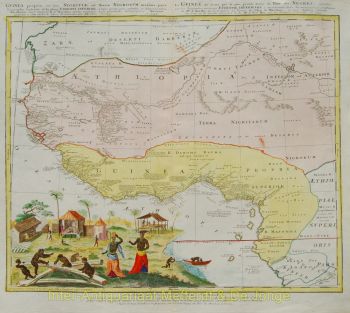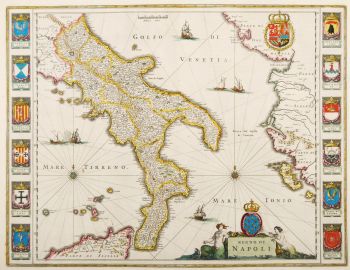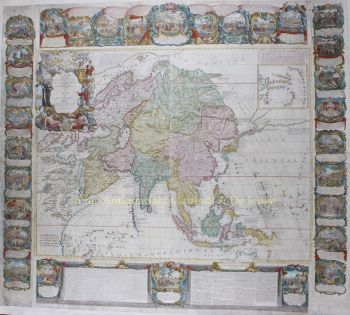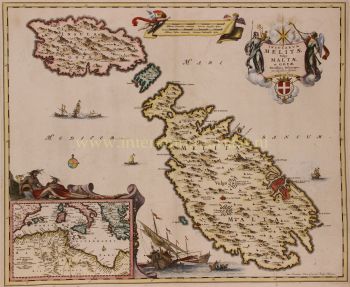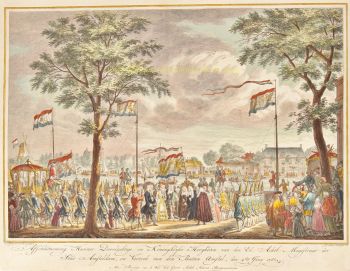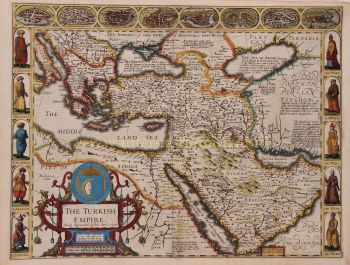Mapa de Creta 1680
Frederick de Wit
€ 1.450
Inter-Antiquariaat Mefferdt & De Jonge
- Sobre arteMAP OF CRETE "Insula Candia Ejusque Fortificatio. "Copper engraving by Frederick de Wit, published in Amsterdam c. 1680, with original hand colouring. Size: 46 x 54,5 cm. One of the most decorative maps of Crete, based on the map by Sébastian de Pontault Beaulieu, a French military engineer who had mapped the fortifications of many Mediterranean islands. His map of Crete was published in 1674, only five years after Crete had fallen to the Ottomans after a 21-year siege (the longest siege in history). The Siege of Candia [modern Heraklion], the capital of Crete, was the central event of the sixth Turkish-Venetian War, better known as Cretan War, or War of Candia. It was a conflict between the Republic of Venice and her allies (the Knights of Malta, the Papal States, French volunteers, and pirates from Mani) against the Ottoman Empire and the Barbary States, fought over the Venetian possession of Crete. The war lasted from 1645 to 1669, and was fought in Dalmatia, Crete, and in numerous naval engagements in the Aegean Sea. On the map the seas around the island are filled with galleons and galleys representing this epic struggle. Above the map the title is on a banner held aloft by putti, and the corners have plans of the towns and fortifications of Chania and Heraklion. Under the map are plans of the fortifications of Spinalonga, Rethymno, Tylissos [Thine] and Suda. Price: Euro1.450,-
- Sobre artistaFrederik de Wit nasceu Frederik Hendriksz. Ele nasceu em uma família protestante por volta de 1629, em Gouda, uma pequena cidade na província da Holanda, uma das sete províncias unidas da Holanda. Seu pai Hendrik Fredericsz (1608 - 29 de julho de 1668) era um hechtmaecker (fabricante de cabo de faca) de Amsterdã, e sua mãe Neeltij Joosten (falecida antes de 1658) era filha de um comerciante em Gouda. Frederik casou-se em 29 de agosto de 1661 com Maria van der Way (1632–1711), filha de um rico comerciante católico em Amsterdã. De cerca de 1648 até sua morte no final de julho de 1706, De Wit viveu e trabalhou em Amsterdã. Frederik e Maria tiveram sete filhos, mas apenas um Franciscus Xaverius (1666-1727) sobreviveu a eles. Em 1648, durante o auge da Idade de Ouro holandesa, De Wit mudou-se de Gouda para Amsterdã. Já em 1654, ele abriu uma gráfica e loja com o nome de "De Drie Crabben" (os Três Caranguejos), que também era o nome de sua casa na Kalverstraat. Em 1655, De Wit mudou o nome de sua loja para "Witte Pascaert" (a Carta Branca). Com esse nome, De Wit e sua empresa tornaram-se conhecidos internacionalmente.
Você está interessado em comprar esta obra de arte?
Artwork details
Categoria
Related artworks
- 1 - 4 / 4
Cornelis Anthonisz Theunissen
VERY RARE FIRST PRINTED MAP OF AMSTERDAM, A CITY ON THE RISE1544
€ 175.000Inter-Antiquariaat Mefferdt & De Jonge
 Curated by
Curated byDanny Bree
Unknown artist
A large wall map of Asia by Nicolas de Fer 1647 - 1720
Price on requestZebregs & Röell - Fine Art - Antiques
1 - 4 / 24- 1 - 4 / 12











